There are already many aids for visual impairment. In particular, smartphones, voice assistants and other technical solutions provide great services for severely impaired vision. But not all aids are suitable for the elderly.
That’s why we’re taking a “close look” at the suitability of aids for visual impairment in old age:
Of course, this makes a huge difference, especially when choosing assistive devices! Age also plays a decisive role. That is, whether someone is visually impaired from birth, or loses vision in old age.
While blindness is on the decline because of the good therapy possibilities, the number of people with visual impairment is increasing. Already 60% of all people over the age of 16 wear glasses.
Those whose vision is less than 30% despite wearing glasses are considered visually impaired.
While magnifying glasses, large type, strong contrasts and bright lighting are suitable aids for visual impairment, they are of no use at all to blind people. Vice versa, Braille and tactile guidance systems, for example, are useless for people, whose vision only deteriorates with age.

Reading magnifiers are available with different magnifications.
Because people are getting older, the number of visually impaired people is also increasing.
In older people, the most common causes are macular degeneration, glaucoma and diabetic retinopathy. In these cases, vision deteriorates more and more, often to the point of blindness.
Therefore, it is very important to acquire aids as early as possible and to become familiar with them.
For the opinion: “I don’t need such a thing (yet)” affected people often pay only years later.
When they can no longer see. And they can no longer learn anything new: Voice assistants and smartphones, electronic magnifiers, navigation apps, even glasses that can recognize the other person and read out signs.
Great helpers in everyday life, if you can operate them!
A person who turned almost completely blind at the age of 85, and has never had anything to do with the Internet and smartphones, will hardly be able to do that.

Smartphones are great aids for visual impairment, if learned on time.
As we age, we often experience not only visual impairment, but also mobility limitations and neurological disorders.
Therefore, all assistive devices should be as easy to use as possible.
So don’t get carried away by (too) many helpful functions. Because that also means more complicated operation!
E.g. an electronic magnifier, where you can switch between photos and text, but also between contrast variations and font sizes.
Finding the right settings, when the keys are barely recognizable, you lack any understanding of technical devices, and you constantly forget, which keys are for what: Almost an impossible task.
A good optical magnifier with illumination is better. Or a very simple device that just has an on/off button.
Or a tactile NFC tag that reads out its contents as soon as you touch it with a smartphone.
Good solutions are also talking wristwatches, scales or thermometers: Just press a button and you can hear the time, weight or temperature.
This is much easier than learning voice commands for Alexa!
The selection of such aids for visual impairment is huge, with over 1000 talking devices listed on Amazon. Relevant aid organizations advise on the choice, many also run their own stores with aids for visual impairment.

For elderly people aids for visual impairment must be extremely easy to use!
Why accessible information in text AND speech can increase the reach of your message by up to 50 %.
read moreHow print media gain more reach with accessiblity
read moreZeroCon23 - THE event for the accessibility topic
read moreWhy Universal Design instead of special solutions is the right approach for inclusion
read moreShowcase of an accessible and inclusive hotel
read moreWhy the 2-senses principle is important and how to implement it
read moreFind out how Siri and Alexa promote sustainability in marketing
read more